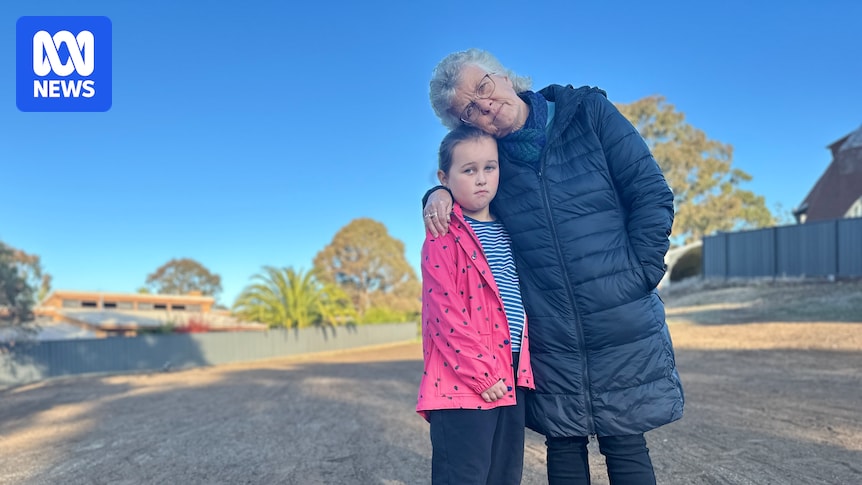When eight-year-old Viv was told her local playground had been ripped out without notice, she burst into tears.
Viv said she had a small backyard at home and loved visiting the park with her family.
“I’m annoyed because I just got to touching the ground on the monkey bars and they’ve just taken it away,” she said.
Her grandmother Janine Welton is “appalled” that she and other neighbours were not notified the playground in the Bendigo suburb of Strathdale was being removed.
“It was gone before we even knew it was going,”
Ms Welton said.
“I’m really disappointed.”
Viv, 8, says she spent hours mastering the monkey bars at her local playground. (Supplied: Janine Welton)
The playground in Sherpa Court was one of 28 earmarked for removal by the Greater Bendigo City Council in a 2019 public space plan.
Its implementation, in some cases years down the track, has left residents shocked.
Aileen Smith lives next door to the Sherpa Court play space and was only alerted to its removal by the sound of an angle grinder from over her fence.
She said the loss had upset the whole neighbourhood.
“It’s not just a park, people have got a connection to this space and it’s an extension of our own homes,” she said.
The council said in a statement the playground had “limited access, poor visibility, surveillance and safety”, and was located 260 metres from another play space.
Greater Bendigo Mayor Andrea Metcalf acknowledged residents were not notified and apologised.
“Residents should be informed when things are going to happen in their areas,”
she said.
The council said there were “no immediate plans” for the future of the site.
Janine and Viv are furious the council did not tell them the playground was being removed. (ABC Central Victoria: Sarah Lawrence)
Playgrounds, parks to go in Greater Bendigo
Through the 2019 public space plan, 28 play spaces across Greater Bendigo were expected to be decommissioned.
Some are already gone, and 26 new playgrounds have been proposed over 20 years, according to council documents.
Greater Bendigo City Council director Brian Westley said the plan considered the equitable distribution and proximity of play spaces.
“In the past four years, there has been an investment of $7 million in new and renewed play spaces across the municipality,” he said.
The plan has also led to two small parks being listed for possible sale by the council, after being deemed “potentially surplus” land.
Kennington resident Hunter Gill said he was suspicious a reserve near him would be sold off by council after a sandpit and cricket nets were removed a few years ago, also without warning.
He was among dozens of residents who signed a petition calling for the space to be retained, and hoped a playground would be reinstated.
Kay Hamilton (front) fears the Greater Bendigo Council will remove a park out the front of her house. (ABC Central Victoria: Sarah Lawrence)
Meanwhile, in Spring Gully, Kay Hamilton was worried the council would sell off her local reserve for a townhouse development.
She said she saw regular foot traffic through the reserve, which is also a community gathering place, including for the neighbourhood Christmas party.
“The trees provide pockets of shade through the summer, two of them have public seats under them and the flatness of the site enables activities for the young and the old,” Ms Hamilton said.
C Metcalf said council would consider community feedback on the potential sale of surplus land before making a decision.
Ms Welton said the removal of playgrounds flew in the face of Greater Bendigo’s history as Australia’s first Child Friendly City, a title awarded by UNICEF in 2007.
While it is no longer part of that program, Greater Bendigo is a signatory of the Victorian Child Friendly Cities and Communities Charter.
Green space a mental health boost
RMIT urban planner Thami Croeser described the removal of playgrounds and green space as “concerning”.
Thami Croeser says green spaces should be seen as essential infrastructure for communities. (ABC News: Danielle Bonica)
Dr Croeser said having a park within walking distance could improve cardiovascular health, while green spaces helped people process stress.
“It helps our mental health and also the sociability factor. It’s on those park benches where we see our neighbours and form our communities,” he said.
“They play a really important social role.”
Dr Croeser said it was generally rare to have enough green space in urban areas and highlighted the environmental benefits, from creating pockets of cool to absorbing excess stormwater during a flood.
